The Samsung 750 EVO (120GB & 250GB) SSD Review: A Return To Planar NAND
by Billy Tallis on April 22, 2016 8:00 AM EST
Since the introduction of their first consumer TLC SSD with the SSD 840, Samsung's consumer/retail SATA SSD lineup has consisted of two product families: the MLC-based Pro drives, and the TLC-based 840 and EVO drives. The strength of Samsung's SSD controllers and the advantages of 3D NAND have allowed the 850 EVO to maintain a solidly mid-range position in the SSD market well above any other drive using TLC NAND.
Meanwhile, with the strength of the 850 EVO as a near-midrange product - and with pricing to match - like so many other vendors over the last year, Samsung has also been developing a true low cost TLC drive for the mass market. The end result is the Samsung 750 EVO, which we're revieiwng today. The 750 EVO establishes a new budget-oriented product line that competes in the cutthroat low end of the market where price per GB is the most important aspect of the product.
There are several design choices that help minimize the cost of the 750 EVO, aside from the obvious choice of TLC over MLC. The MGX controller it borrows from the lower capacity 850 EVOs is a dual-core version of Samsung's usual triple-core architecture. Similarly, the 750 EVO is only available in 120GB and 250GB sizes, so there is no high-priced high capacity model. Consequently, with only two small capacities, the 750 EVO line is served by a single tiny PCB layout, made even smaller by the fact that Samsung has put the 256MB of DRAM in the same package as the SSD controller.

Samsung MGX controller with onboard 256MB DRAM
But the most significant aspect of the 750 EVO is that it doesn't use the 3D NAND that has been a key competitive advantage for Samsung's 850 product lines. Samsung has continued development of planar NAND even after transitioning their retail SSDs to 3D NAND, and the 750 EVO in turn uses 16nm planar TLC. It doesn't offer the same performance or endurance of Samsung's 3D NAND, but it does significantly lower the cost of the drive.

128GB of 16nm TLC NAND in a single package
The 16nm TLC NAND is the successor to Samsung's 19nm TLC that had a troubled tenure in the 840 EVO. With the 840 EVO, data at rest on the drive degraded over time and eventually required the use of more thorough and thus slower error correction when read back. As a result the 750 EVO inherits the benefits of all the firmware work Samsung did to mitigate the read speed degradation. This, for what it's worth, gives Samsung some degree of a leg-up against other 16/15nm TLC drives that face the same challenges.
| Samsung TLC SATA SSD Comparison | |||||
| Drive | 750 EVO 120GB | 750 EVO 250GB | 850 EVO 120GB | 850 EVO 250GB | |
| Controller | MGX | MGX | |||
| NAND | Samsung 128Gb 16nm TLC | Samsung 32-layer 128Gbit TLC V-NAND | |||
| DRAM | 256MB | 256MB | 256MB | 512MB | |
| Sequential Read | 540MB/s | 540MB/s | 540MB/s | 540MB/s | |
| Sequential Write | 520MB/s | 520MB/s | 520MB/s | 520MB/s | |
| 4KB Random Read | 94K IOPS | 97K IOPS | 94K IOPS | 97K IOPS | |
| 4KB Random Write | 88K IOPS | 88K IOPS | 88K IOPS | 88K IOPS | |
| 4KB Random Read QD1 | 10K IOPS | 10K IOPS | 10K IOPS | 10K IOPS | |
| 4KB Random Write QD1 | 35K IOPS | 35K IOPS | 40K IOPS | 40K IOPS | |
| DevSleep Power | 6mW | 2mW | |||
| Slumber Power | 50mW | 50mW | |||
| Active Power (Read/Write) | 2.1W / 2.4W (Average) | 2.4W / 2.8W (Average) | Max 3.7W / 4.4W | ||
| Encryption | AES-256, TCG Opal 2.0, IEEE-1667 (eDrive) | AES-256, TCG Opal 2.0, IEEE-1667 (eDrive) | |||
| Endurance | 35TB | 70TB | 75TB | ||
| Warranty | Three years | Five years | |||
By and large the performance specifications for the 750 EVO match the lower capacity 850 EVO, though a slightly lower random write speed at a queue depth of one hints that the 750 EVO may require a bit more background wear leveling work. The feature set is identical to the 850 EVO, making the 750 EVO one of the few low-end drives to support TCG Opal encryption.
Samsung's marketing strategy for the 750 EVO is a little different from their previous retail SSD products. The 750 EVO is targeted specifically at system integrators and system builders, rather than at users looking to upgrade an existing machine. Consequently, they aren't pushing to make the 750 EVO available from as wide a range of retail outlets. Enough of the major online retailers have it in stock that it is not difficult to obtain.
This review will focus on comparing the 750 EVO against Samsung's other SATA SSDs and against other current-generation low-end TLC SSDs of comparable capacity. Our Bench tool can assist in making other comparisons.
| AnandTech 2015 SSD Test System | |
| CPU | Intel Core i7-4770K running at 3.5GHz (Turbo & EIST enabled, C-states disabled) |
| Motherboard | ASUS Z97 Pro (BIOS 2701) |
| Chipset | Intel Z97 |
| Memory | Corsair Vengeance DDR3-1866 2x8GB (9-10-9-27 2T) |
| Graphics | Intel HD Graphics 4600 |
| Desktop Resolution | 1920 x 1200 |
| OS | Windows 8.1 x64 |
- Thanks to Intel for the Core i7-4770K CPU
- Thanks to ASUS for the Z97 Deluxe motherboard
- Thanks to Corsair for the Vengeance 16GB DDR3-1866 DRAM kit, RM750 power supply, Carbide 200R case, and Hydro H60 CPU cooler










109 Comments
View All Comments
Shadow7037932 - Friday, April 22, 2016 - link
The prices aren't competitive. The Ultra II in particular tends to go on sale rather often for around $50.Shadow7037932 - Friday, April 22, 2016 - link
Also, if it's anything like the price drop we saw with the 850 EVOs, this could drop down to ~$50 or so in a few months I think.barleyguy - Friday, April 22, 2016 - link
This drive hasn't been out long enough to know what price it will go on sale for. So I consider any comments on pricing pretty irrelevant.Outside of that, there are only 3 brands of SSD I trust my data to, which is Intel, Crucial/Micron, and Samsung. I'll pay more for those 3 brands than I will other brands, because of reliability.
AkulaClass - Friday, April 22, 2016 - link
As 250GB low cost I would grab a SanDisk Ultra II.barleyguy - Friday, April 22, 2016 - link
8 of the 48 reviews of that drive on NewEgg are "worked great until it died in a month and I lost my data". As I said in another post, Intel, Crucial, and Samsung are IMO on a different tier of reliability than everybody else.Shadow7037932 - Saturday, April 23, 2016 - link
I like how you're saying Samsung there without considering the issues they've had with the 840. Out of all three you mentioned, only Intel has had solid SSDs since the first gen.barleyguy - Saturday, April 23, 2016 - link
I actually own an 840 Evo in my daughter's laptop. The issues with it never involved data loss or "early death", only degraded performance. Even in its degraded performance mode it still feels faster than a hard drive. And the patches they issued to "fix" it work pretty well to restore it back to SSD-like performance.So, in short, I still trust Samsung on the SSD front way more than Sandisk.
Though I don't disagree that Intel makes excellent SSDs. They're the way to go for a "critical main desktop" type application.
andrewaggb - Sunday, April 24, 2016 - link
I was going to say that as well. I have an 840 evo in my machine and I haven't lost any data. I regret purchasing it... but it works. The only SSD I've had die so far was a Kingston V100. Still have a couple intel 320 series ssd's running strong, a couple sandisk ones (don't recall the model numbers) that are working and a crucial M500 that is working.Dwedit - Sunday, April 24, 2016 - link
I had the old Intel X25-M, and it had a catastrophic failure where the disk name changed to "BAD CONTEXT" and size changed to 8MB.K_Space - Wednesday, April 27, 2016 - link
X25-M (version 2) still going strong here just not as a main drive since 80Gb is puny. I have both SD Ultra II (960Gb) and 2x Extreme Pro (480Gb) going with no problems. The Extreme Pro was purchased straight after Anadtech glowing review particularly with its 10 years warranty. Not sure what the warranty is for the Ultra II but wouldn't be surprised if its 5+. For every review that says: my SSD died, you'll get a "my SSD is alive & well" so take em with a pinch of salt. It all depends on usage scenario and user expertise and we know how variable that can be.